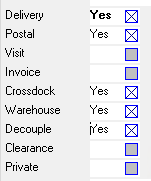There are two screens in Transpas that have many similarities: Financial Relations and Relations.
Both can be found under Go to -> Relationships

¶ Relations
This includes all relationships in Transpas, such as loading/unloading relationships, customs addresses, terminals, and so on.
All financial relations are also relations and are therefore also displayed in this screen, but without the financial data.
¶ Financial relations
A relation is a financial relation if the relation is a debtor or creditor.
In the Financial relations screen, additional data about this relation is stored, such as the VAT number, bank account numbers and other information relevant for invoicing.
A relation can only be filled in as Customer for a booking / shipment if he or she is also a debtor.
¶ Creating a financial relation
A financial relation is created in the Relations screen by checking under the General tab that the relation is a debtor or creditor:

A financial relation is always also a relation, but a relation is only a financial relation if the Debtor and/or Creditor checkbox is checked. Only then will it also become visible under Financial relations.
Do not create a financial relation in the Financial Relations screen. If the relation already exists in the Relations screen, but is not yet a debtor/creditor, a new relation is created.
Also see:
¶ Deleting Financial relations
Do not delete a Financial relation!
If no more orders will be transported for a customer, it can be set to inactive.
This is better than deleting, because deleting also ensures that the customer name is no longer visible in transport bookings for this customer.
A relation can be made inactive via the green button with the check mark in the task bar:

In the dropdown menu (in the screenshot below on the right) you can choose which relationships should be visible:

| Active | only active relationships |
| In-active | only inactive relationships |
| * | All relationships |
¶ Relaties delen
Relations can be shared between the different companies in Transpas.
Debtors/creditors can not be shared. The reason behind this is that the financial data for a relation can differ per company: for example, the debtor number can differ per company. To make this possible, a financial relation is unique per company.
Also see:
¶ Adresses
One or more addresses can be added to a (financial) relationship, which are visible on the Addresses tab.
Each address also has a type (postal address, delivery address, billing address, etc.):

These attributes can be selected for each address on the Address Details tab.
Only if Delivery is set to Yes, this address can be entered as a loading or unloading address.
General address
Which address is displayed under the General tab and in the top grid depends on the type and the screen:
- In the Financial Relations screen, this is the address where Postal Address is checked
- In the Relations screen, this is the address where Delivery is checked